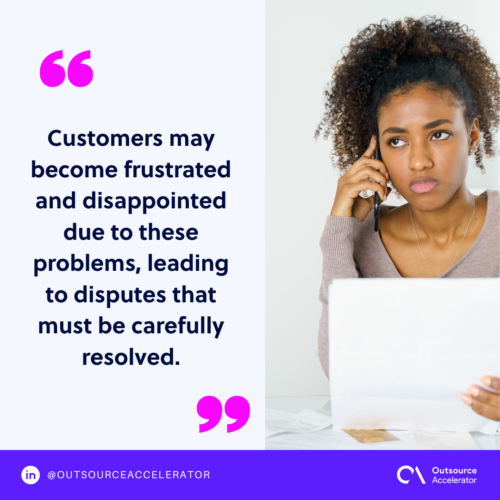A guide to customer conflict management

Dealing with customer conflict is inevitable for any business. How a business manages and resolves these conflicts can significantly affect its reputation and customer satisfaction.
The proactive identification, resolution, and prevention of issues that could cause customer dissatisfaction are all part of customer conflict management.
Customer conflict 101
A customer conflict is any disagreement or dispute between a company and its clients.
Miscommunications, inconsistent invoicing, problems with the overall quality of the good or service, or general discontent with the customer experience could all cause this.
Identifying and classifying these conflicts is essential for effective customer conflict resolution strategies.

Importance of addressing customer conflict
Unresolved conflicts can escalate, leading to negative word-of-mouth, damaging reviews, and potential loss of customers.
In today’s interconnected world, where information spreads rapidly through various online platforms, the impact of dissatisfied customers can be detrimental to a company’s reputation.
Addressing customer conflicts effectively can result in:
- Customer satisfaction. Effective conflict resolution demonstrates a commitment to customer satisfaction and helps build trust.
- Customer loyalty. Customers appreciate companies that take their concerns seriously and work towards finding fair and satisfactory resolutions. It fosters long-term customer loyalty and positive brand associations.
- Continuous improvement. Customer conflicts provide valuable insights into areas where the business can improve its products, services, or communication processes. Addressing these conflicts helps in continuous improvement.
Why do customer conflicts happen?
Understanding the root causes of customer conflicts is essential for developing proactive strategies.
Businesses can implement preventive measures and enhance customer experience by identifying common triggers, such as the following:
Miscommunication
Misunderstandings frequently result from poor communication channels, imprecise messaging, or a lack of openness by companies and their clients.
In today’s fast-paced digital world, miscommunication can happen on several channels, including social media, phone calls, and emails.
Customers and businesses may disagree because of misunderstandings of terms, conditions, or promises. For example, customers may feel frustrated and unsatisfied if they receive conflicting information regarding the product’s delivery date.
Additionally, a breakdown in customer relations can be caused by a lack of clear and concise communication.
Unmet expectations
Conflict might arise when customers have certain expectations for a good or service that are not met. Inconsistencies between what customers think they will get and what the company provides often cause unfulfilled expectations.
Through marketing campaigns or ambiguous product descriptions, businesses may inadvertently set up unreasonable expectations.
Disagreements may arise due to a mismatch between the customer’s expectations and the experience they receive.
Product or service issues
Even with the best-intentioned efforts, businesses occasionally experience:
- Product defects
- Services that fall short of expectations
- Unanticipated difficulties that crop up during the delivery
Customers may become frustrated and disappointed due to these problems, leading to disputes that must be carefully resolved.
Problems with products or services can be caused by several things, such as:
- Mistakes made during manufacturing
- Problems with the supply chain
- Insufficient quality control procedures

Customer conflict resolution tips for 2024
The process of recognizing, addressing, and resolving conflicts between a company and its customers is known as customer conflict resolution.
To resolve conflicts successfully, it’s important to understand the root cause, show empathy toward the customer’s concerns, and propose solutions aligned with the business’s values.
Efficient customer conflict resolution should have the following elements:
Clear complaints procedure
By 2024, companies should prioritize creating and disseminating a transparent procedure allowing clients to file complaints.
This entails ensuring that the company website, customer support channels, and, if applicable, physical locations provide easy access to information about filing a complaint.
Customers should have little to no trouble voicing their concerns through an easy-to-follow complaints procedure.
To monitor and promptly handle complaints, businesses should implement effective tracking systems to prevent customer conflict escalations.
Reflective listening and tactical empathy
Customer service representatives use reflective listening by paying attention, validating feelings, and paraphrasing customer concerns. This method guarantees that the client feels understood and heard.
Beyond basic empathy, tactical empathy acknowledges the conflict’s emotional component.
When customer service representatives show empathy and acknowledge the customer’s feelings, they can establish rapport and reduce stress.
A sincere apology can be very helpful to diffuse a conflict. Even in cases where the business is not at fault, apologizing to the customer for their experience demonstrates compassion and dedication to finding a solution.
Find a solution that pleases the customer rather than placing blame.
Importance of body language
Body language is the non-verbal cues we convey through gestures, facial expressions, and posture. It can significantly influence the outcome of customer conflicts.
Maintain open and welcoming body language to signal receptiveness and attentiveness.
Training employees to be aware of their body language and interpret customers’ cues can prevent misunderstandings in handling customer conflicts. This includes maintaining open and positive postures, appropriate eye contact, and being mindful of facial expressions.
Create a systematic resolution process
Fairness and consistency are ensured by implementing a systematic procedure for resolving customer conflicts. Establish specific guidelines for staff members, such as:
- Recording the problem
- Determining the root cause
- Carrying out the resolution plan
Review and update this procedure regularly to accommodate evolving industry trends and client needs.
In today’s competitive business world, dedication to prompt and customer-focused dispute resolution is critical for long-term success.







 Independent
Independent




